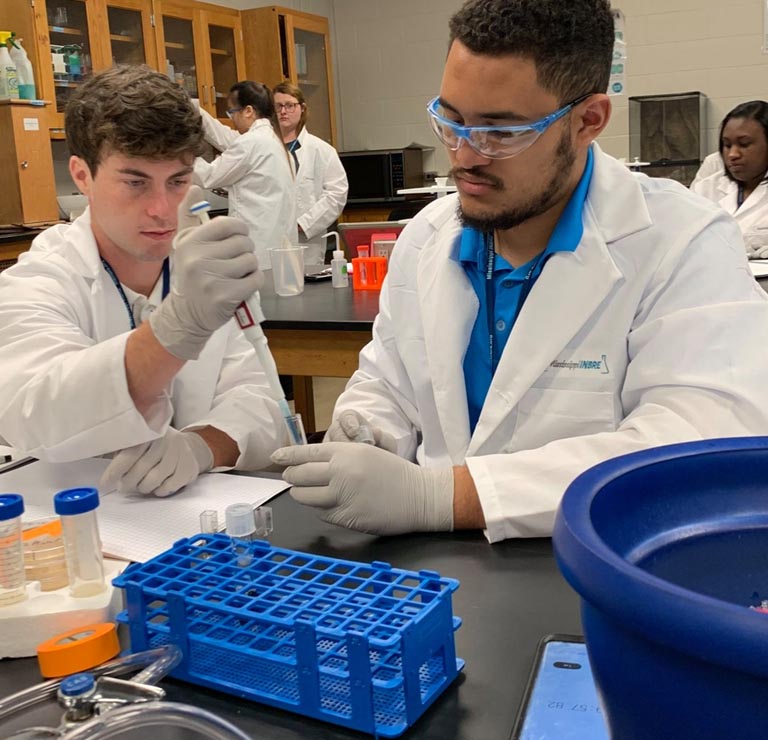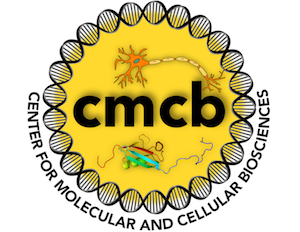Center for Molecular and Cellular Biosciences
Research in Molecular and Cellular Biosciences
Page Content
Active research programs in the CMCB include critical areas such as infectious diseases, public health, conservation genetics, mast cell exocytosis and more.
Research Feature
Project: New Inhibitors Targeting HIV-1 Integrase During Viral Maturation
- Begin Date: 8/8/19
- End Date: 7/31/24
- Prime Sponsor: National Institute of Allery and Infectious Disease (NIAID), National Institutes of Health (NIH)
The treatment of AIDS patients with Highly Active Anti-Retroviral Therapy (HAART) has transformed the prognosis of an HIV infection from a once deadly illness to a chronic manageable disease.
HAART is a combination therapy of small molecule inhibitors that target essential viral enzyme of the HIV replication. However, the rapid development of HIV resistance to almost all currently used antiviral agents is a major clinical problem. In the absence of an effective vaccine there is an urgent need to continually develop new strategies against as yet unexploited targets.
My research focuses on understanding the fine molecular mechanisms of HIV replication. I use a combination of biochemistry, biophysics and ex vivo approaches to discover critical interactions (within the virion or between host and viral components) in order to devise novel molecular strategies capable of blocking viral replication. Newly found inhibitors emerging from these studies can also serve as powerful molecular probes to observe unknown aspects of viral biology which in turn will reveal new unexploited targets. I have discovered that pursuing these two research directions simultaneously (viral biochemistry and antiviral drug discovery) maximizes productivity in term of scientific breakthroughs.
My research has been continuously funded at the highest level by the National Institute of Health (NIH) since 2011. More recently, I have been awarded a very competitive R01 grant (the gold standard of biomedical research, about $1.8M) to continue my HIV research.
| Public Health Relevance: HIV-1 integrase is essential for viral replication and its catalytic activity is currently exploited as drug target. In the present application we will characterize at the molecular level the newly discovered non-catalytic function of HIV-1 integrase during viral maturation and design new allosteric inhibitors. |
Active Projects

Project: Mississippi INBRE
Begin Date: 9/1/23
Prime Sponsor: U.S. Dept of Health and Human Services
The Mississippi IDeA Network of Biomedical Research Excellence (MS INBRE) is a statewide network dedicated to enhancing the biomedical research infrastructure among all higher education institutions in Mississippi.
The overall goal of the network is to address health disparities and inequities by improving leadership and knowledge concerning biomedical research and to increase awareness of health disparities prevalent in Mississippi. With this goal in mind, MS INBRE has developed its activities around three scientific themes that are major impacts on Mississippians: cancer, infectious diseases, and obesity. Mississippi is ranked third lowest in the United States in terms of access to healthcare, primarily owing to the state’s poor economy and historically low investment in health care infrastructure. MS’s biomedical research infrastructure has lagged in comparison to other states, which creates a vicious cycle in which it is more difficult to make improvements in health care equality and availability. Mississippi is improving its health care and biomedical research infrastructure to improve the health of the population.
|
MS INBRE has played a key role in improving the biomedical infrastructure at partner institutions and in educating and training underserved communities that have historically suffered from severe health disparities. We have developed the following aims to carry out the overall goal of MS INBRE:
At the completion of the proposed project, we will augment the competitiveness of Mississippi in biomedical research by improving the biomedical infrastructure at undergraduate institutions and training of students. |
Project: Novel approaches for the discovery of dephosphorylation control in oocyte meiosis
- Begin Date: 9/1/22
- End Date: 8/31/26
- Prime Sponsor: National Institute of Child Health and Human Development (NICHD), National Institutes of Health (NIH)
Abstract
Precise regulation of M-Phase in oocyte meiosis is essential for successful embryo
development and female fertility. Highlighting this, ~1% of women are subfertile/infertile
due to meiotic failure. Despite this, the precise molecular mechanisms governing M-Phase
is only partly understood in oocytes. This research will focus on the phosphatase
PP1 (Protein Phosphatase 1). PP1 is an important regulator of mitotic M-Phase and
is responsible for ~50% of all dephosphorylations. However, the specific roles of
PP1 in mammalian oocytes is unclear. PP1 is a holoenzyme consisting of a catalytic
subunit (PP1c) and one to two PP1 regulatory proteins (Regulatory Interactors of Protein
Phosphatase One; RIPPO). In mammalian cells, there are three PP1cs (α, β, and γ) and
>180 RIPPOs. Historically, PP1 research has focused on PP1c in isolation, leading
to the misconception that PP1c is promiscuous. However, RIPPOs control localization,
enzyme activity, and substrates of PP1c. Additionally, disease states mediated by
aberrant PP1 function (e.g., heart disease) result from changes in the PP1c interactome,
and not PP1c. Furthermore, studies of PP1c in oocytes, using dual PP1/PP2A inhibitors,
overexpression, and anti-PP1c antibody injections, have yielded conflicting outcomes.
Recent data from our lab using a selective PP1c inhibitor, a specific PP1c activator,
and a novel RIPPO-based PP1c inhibition approach found PP1 is essential for normal
meiosis I completion. Importantly, this data points to a novel, but crucial role for
PP1 in prometaphase. To gain further insights into oocyte meiosis, this proposed research
will: (1) develop novel tools for the specific and temporal control of PP1c throughout
M-Phase to resolve controversies and unknowns about the roles of PP1 in oocytes and;
(2) determine the essential roles of PP1 in oocyte meiosis. In Aim 1, a novel method
for reversible small molecule-mediated caging will be developed -- auxin-controllable
caging (ACC). ACC will be used to specifically and temporally regulate PP1c, further
defining the roles of PP1c in oocyte meiosis. Specifically, investigating the novel
prometaphase role for PP1c. Of note, this new state-of-the-art tool can be used to
study any protein-of-interest. Finally, Aim 2 will use both hypothesis-driven and
discovery-driven approaches to determine PP1 holoenzyme function and formation during
meiosis. This aim will establish the function of two PP1 holoenzymes (PP1c:PNUTS and
PP1c:NIPP1), and map the PP1c interactome throughout oocyte meiosis. Overall, this
project will shed light on a poorly understood, but health-relevant phosphatase, PP1,
elucidating its functions in oocytes and more broadly M-Phase regulation. Ultimately,
this work will develop a highly valuable tool for the research community, and inform
the development of novel treatments for M-Phase based diseases including infertility.
Project: Searching for sawfish in northern Peru
- Begin Date: 2023
- End Date: 2024
- Prime Sponsor: Save Our Seas Foundation
Project: eDNA surveys for the Eastern Hellbenders (Cryptobranchus alleganiensis) in Tishomingo County, Mississippi
- Begin Date: 2023
- End Date: 2024
- Prime Sponsor: Mississippi Department of Wildlife, Fisheries, and Parks
Project: Comprehensive eDNA surveys for the Western Chicken Turtle (Deirochelys reticularia miaria) in Western Mississippi.
- Begin Date: 2023
- End Date: 2024
- Prime Sponsor: Mississippi Department of Wildlife, Fisheries, and Parks
Project: Monitoring and predicting responses of a sentinel marine megafauna to climate change and implications for the tropicalization of the northern Gulf of Mexico.
- Begin Date: 2021
- End Date: 2024
- Prime Sponsor: U.S. Department of Treasury RESTORE Act
Project: Greater Amberjack (Seriola dumerili) Research to Determine Abundance Estimates by Habitat Type, Distribution, and Movement in U.S. Waters in the South Atlantic and Gulf of Mexico Regions.
- Begin Date: 2021
- End Date: 2024
- Prime Sponsor: Mississippi-Alabama SeaGrant
Project: Greater Amberjack (Seriola dumerili) Research to Determine Abundance Estimates by Habitat Type, Distribution, and Movement in U.S. Waters in the South Atlantic and Gulf of Mexico Regions.
- Begin Date: 2021
- End Date: 2024
- Prime Sponsor: Save Our Seas Foundation





